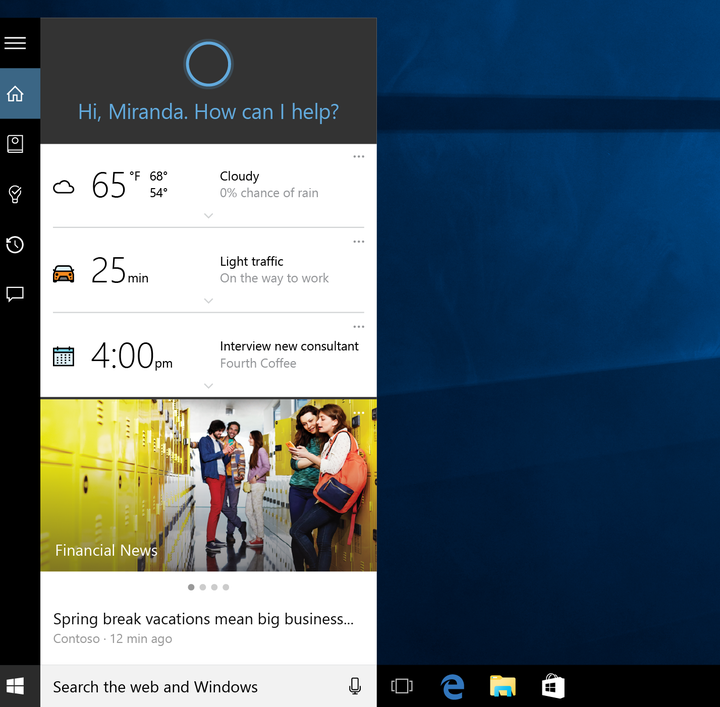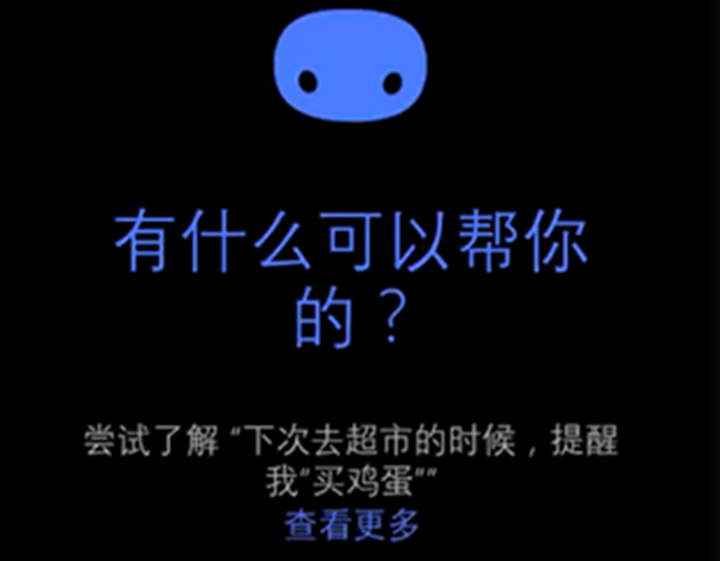
Apple has Siri, the iPhone and iPad "assistant" that listens to your voice commands and offers you information on demand. Google offers "Google Now," a similar service. And now, Microsoft is hoping you'll get to know Cortana.
When Windows 10 launches on Wednesday, Cortana is coming with it. The digital assistant was previously available on Windows Phone devices, but now it's baked into the company's main operating system, right next to the revamped Start menu. It'll basically do what you expect: Cortana can tell you what's next on your calendar, give you directions, remind you to buy milk, show you the latest headlines, let you know if your stocks are tanking and so on. Like Siri, Cortana might get a little sassy, depending on what you ask.
But while the functionality isn't really groundbreaking in 2015, Microsoft hopes its assistant has an edge over the competition: It's designed to act like a human person. (Fancy that.)
For example, if you ask it about the weather, Cortana might say, "Right now, it's 82 and mostly sunny." Ask the same thing to Siri, and it responds, "Here's the weather between today and August 6, 2015" -- then, it displays a forecast on screen. If you asked the person next to you what the weather's like, you can probably imagine which answer theirs would be closer to.
That said: Who cares? It's a crowded marketplace, and you're probably not going to buy a new Windows machine just to have a somewhat friendlier digital assistant. But if you're an existing Windows user -- the vast majority of people in the world are -- Cortana might be a compelling enough reason to try the free Windows 10 upgrade. The digital assistant might also be an interesting augur of what's to come for rival services.
To find out more about Cortana, The Huffington Post spoke with Kat Holmes, a design director at Microsoft who worked on the software.
This interview has been edited and condensed for clarity.

What's going to surprise people about Cortana on Windows 10?
Kat Holmes: There are a lot of digital assistants out there. But the thing we poured our heart into with Cortana is how can we make her personal to you. What we found is that two things really helped bring that personal aspect to life. The first is how Cortana behaves. Her voice, her character -- her personality. We spent a lot of time with the character design of Cortana. It's not about anthropomorphizing your computer, it's about these little moments of playfulness, and these moments of recognition that she's listening to what you're asking her and what's important to you.
The other piece in making her personal is the proactivity. There are things you can tell her about you that you want her to know, that you want her to be more proactive about. If I tell Cortana "here's my home, here's my work," then each morning Cortana lets me know before my commute that I may need to get on the road a little earlier today. It's that proactivity that's magical for people. But also because I, as a customer, have taken a moment to let Cortana know what's important to me. Taking that step is a really important piece of trust, that it's okay for her to know what these locations are.
There's much broader things that we do on the PC, things that we really will focus in on. "Oh shoot, I need to remind myself later to pick something up on my way home," or "I need to get my hair done." I can do these things quickly [from my computer] -- "Hey, Cortana, can you set up an appointment on my calendar tonight to call my mom?"

Cortana's default image is a simple circle. But in China, the virtual assistant is able to take on a different, "MianTuan" form: It's supposed to look like a "bun." A spokeswoman for Microsoft said that, in an online poll, over half of the Windows Phone-using respondents reported switching to this alternate shape.
Actual, human personal assistants lent their expertise as part of the Cortana design process. Tell me more about that.
KH: A passion point was this idea of making Cortana personal. The trick is that none of us have any experience actually being a personal assistant or having a personal assistant. The epiphany was, there are human beings in this world that do this for a living.
There is so much that we can learn from how human beings interact with each other and support each other and play these roles in each other's lives.
How do they prioritize, what emotional aspects are important to doing that role very well? What goes into making someone a personal assistant rather than a task-completion assistant?
We spoke to about 15, what we would call high-functioning, top personal assistants in the world. [For] A-list actors, C-suite executives at a number of large companies. We asked, "What are the things that are important to the role?"
We found that there were commonalities with everyone we spoke with. My favorite one was, everybody kept some kind of handbook. Some of them referred to it as a bible. They kept all of their information on their client. All of the idiosyncracies, all of the things to get their jobs done -- this person doesn't like brown M&M's. Quirky things. Things like, what times of days are best to bring new ideas to someone, or what's the best time of day to leave someone alone.
We took that notebook example pretty seriously to heart. With a phone or a computer, there's no trust button you can create. Relationships are built over time and trust is built into that. So, we built the Cortana notebook as a place where we could make it transparent to customers. What is Cortana learning about me? What do I want her to know? What do I want to correct? Maybe she thought I was a fan of the NCAA, but actually I'm just trying to win my bracket. When [the tournament] was done, I didn't need anything else [about basketball]. I could go in there and let her know. That transparency gives people a starting point and a trust for what Cortana is learning about them over time.
When using Cortana in Windows 10, I was surprised that a lot of the time, it would just open Bing searches to find my answers. I expected to feel more like I was talking to someone. Can you tell me more about the right way to use Cortana?
KH: I think it's really fun and playful to ask Cortana, what are some of the things you can do? Or, tell me a joke, or what are some of the things happening in the world right now? I love asking her about food and restaurants nearby, helping her get acquainted to the things that are important to me.
Some of the most helpful things are the people I'm thinking about all day. If I'm at work, there are things I'm thinking of as a mom, or a partner, or a friend. Being able to set Cortana up to help me with those things throughout the day is one of the most helpful things. Take the time to let her know the people who are important to you, how you naturally say your name.
What would you say to make people more comfortable giving this information to Cortana?
KH: With any device we bring into our lives, it's important to think about it as a relationship that grows over time. There are so many things that devices are capable of. The things I tell folks is, go at the steps you're comfortable with. Trust is about an exchange of value. For what you're giving, are you receiving a value back from the experience? Make that a measure of how much we're willing to contribute or share.
It's on us as designers to learn from modern human behavior, and to evolve our products to meet people where they are, as opposed to the burden being on my mom.
